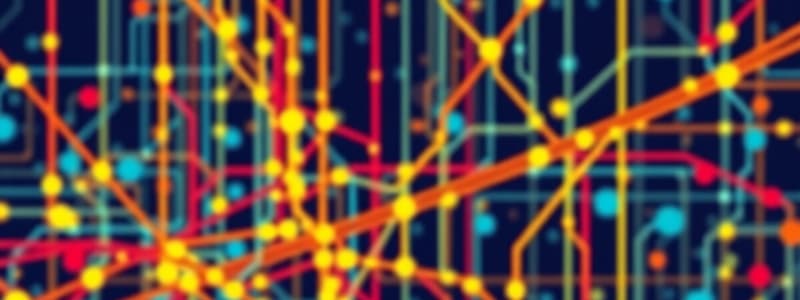Podcast
Questions and Answers
What are the primary types of physical infrastructure that support the Internet?
What are the primary types of physical infrastructure that support the Internet?
The primary types include fiber optic cables, copper cables, routers, servers, and data centers.
How do HTTPS and FTP differ in terms of their functions on the Internet?
How do HTTPS and FTP differ in terms of their functions on the Internet?
HTTPS is used for secure web browsing, while FTP is specifically designed for transferring files between computers.
What role do organizations like ICANN and IETF play in Internet governance?
What role do organizations like ICANN and IETF play in Internet governance?
They manage policies related to domain names, IP addresses, and technical standards to ensure a stable and functional Internet.
What are two major cybersecurity threats affecting users on the Internet?
What are two major cybersecurity threats affecting users on the Internet?
Describe one major trend in the future of the Internet and its potential impact.
Describe one major trend in the future of the Internet and its potential impact.
Flashcards are hidden until you start studying
Study Notes
Overview of the Internet
- Global network of interconnected computers.
- Facilitates communication, information sharing, and access to services.
Key Components
-
Infrastructure
- Physical cables (fiber optic, copper).
- Routers and servers.
- Data centers.
-
Protocols
- TCP/IP: Fundamental communication protocols.
- HTTP/HTTPS: Protocols for web browsing.
- FTP: File Transfer Protocol for transferring files.
-
Web Technologies
- HTML: Markup language for creating web pages.
- CSS: Stylesheets for design and layout.
- JavaScript: Programming language for interactive elements.
Major Functions
- Email: Electronic communication via email services.
- Web Browsing: Accessing websites and online content.
- Social Media: Platforms for networking and sharing (e.g., Facebook, Twitter).
- Online Services: E-commerce, banking, cloud storage.
Internet Governance
- Managed by various organizations (e.g., ICANN, IETF).
- Policies for domain names, IP addresses, and standards.
Security Concerns
- Cybersecurity threats: Malware, phishing, data breaches.
- Encryption: HTTPS for secure data transmission.
- Privacy issues: Data collection, surveillance, user consent.
Future Trends
- Increased use of Internet of Things (IoT).
- Expansion of 5G networks for faster connectivity.
- Growing emphasis on privacy and data protection laws.
Impact on Society
- Changed communication methods and social interaction.
- Access to vast amounts of information and education.
- Evolving job markets and industries due to digital transformation.
Overview of the Internet
- A global network connecting millions of computers worldwide, enabling communication, information sharing, and access to a variety of services.
Key Components
- Infrastructure: Consists of physical elements like fiber optic and copper cables, routers, servers, and vast data centers that support internet functionality.
- Protocols:
- TCP/IP: The foundational communication protocols that enable data transmission over the internet.
- HTTP/HTTPS: Protocols specifically designed for web browsing, ensuring secure connections with HTTPS.
- FTP: A standard protocol used for transferring files between systems on a network.
- Web Technologies:
- HTML: The standard markup language utilized for creating the structure and content of web pages.
- CSS: Cascading Style Sheets used for styling and layout of web documents, enhancing visual presentation.
- JavaScript: A programming language used to create interactive and dynamic elements on web pages.
Major Functions
- Email: A primary means of electronic communication, providing services for sending, receiving, and organizing messages.
- Web Browsing: Enables users to access and navigate through websites and various online content.
- Social Media: Platforms like Facebook and Twitter facilitate networking, social interaction, and content sharing among users.
- Online Services: Encompasses a range of functionalities such as e-commerce, online banking, and cloud storage services.
Internet Governance
- Oversight is provided by organizations such as ICANN and IETF, which establish policies regarding domain names, IP addressing, and internet standards.
Security Concerns
- Cybersecurity Threats: Risks include malware attacks, phishing scams, and data breaches affecting user privacy and data integrity.
- Encryption: HTTPS is critical for securing data during transmission, protecting against interception.
- Privacy Issues: Ongoing challenges include data collection practices, government surveillance, and the need for informed user consent.
Future Trends
- Internet of Things (IoT): Increasing integration and use of devices connected to the internet, enhancing automation and connectivity.
- Expansion of 5G Networks: Offers potential for significantly improved internet speeds and connectivity options.
- Privacy and Data Protection: Growing awareness and legislation focused on securing personal data and ensuring user privacy rights.
Impact on Society
- Revolutionized communication methods, altering how individuals interact socially.
- Provides access to vast educational resources and information, empowering users.
- Drives transformation in job markets and industries, leading to new opportunities and challenges in the digital economy.
Studying That Suits You
Use AI to generate personalized quizzes and flashcards to suit your learning preferences.




